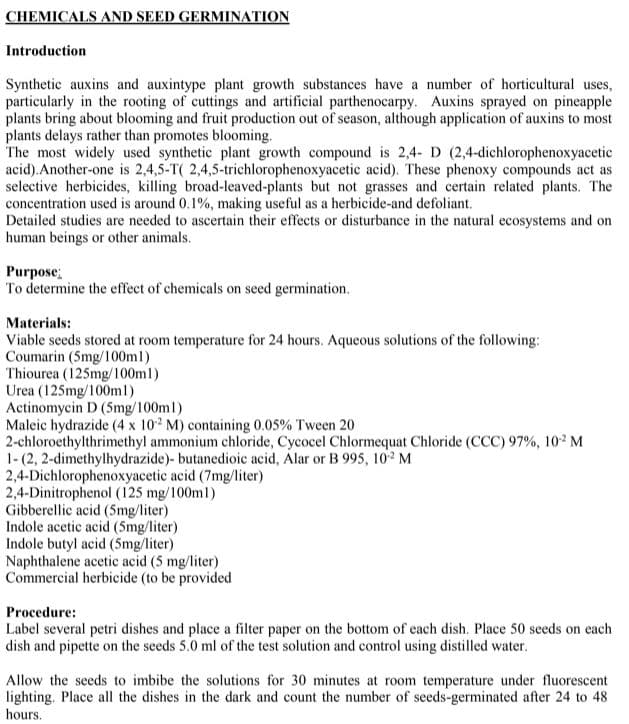CHEMICALS AND SEED GERMINATION Introduction Synthetic auxins and auxintype plant growth substances have a number of horticultural uses, particularly in the rooting of cuttings and artificial parthenocarpy. Auxins sprayed on pineapple plants bring about blooming and fruit production out of season, although application of auxins to most plants delays rather than promotes blooming. The most widely used synthetic plant growth compound is 2,4- D (2,4-dichlorophenoxyacetic acid).Another-one is 2,4,5-T( 2,4,5-trichlorophenoxyacetic acid). These phenoxy compounds act as selective herbicides, killing broad-leaved-plants but not grasses and certain related plants. The concentration used is around 0.1%, making useful as a herbicide-and defoliant. Detailed studies are needed to ascertain their effects or disturbance in the natural ecosystems and on human beings or other animals. Purpose; To determine the effect of chemicals on seed germination. Materials: Viable seeds stored at room temperature for 24 hours. Aqueous solutions of the following: Coumarin (5mg/100ml) Thiourea (125mg/100ml) Urea (125mg/100ml) Actinomycin D (5mg/100ml) Maleic hydrazide (4 x 102 M) containing 0.05% Tween 20 2-chloroethylthrimethyl ammonium chloride, Cycocel Chlormequat Chloride (CCC) 97%, 10² M 1-(2, 2-dimethylhydrazide)- butanedioic acid, Alar or B 995, 10 M 2,4-Dichlorophenoxyacetic acid (7mg/liter) 2,4-Dinitrophenol (125 mg/100ml) Gibberellic acid (5mg/liter) Indole acetic acid (5mg/liter) Indole butyl acid (5mg/liter) Naphthalene acetic acid (5 mg/liter) Commercial herbicide (to be provided
CHEMICALS AND SEED GERMINATION Introduction Synthetic auxins and auxintype plant growth substances have a number of horticultural uses, particularly in the rooting of cuttings and artificial parthenocarpy. Auxins sprayed on pineapple plants bring about blooming and fruit production out of season, although application of auxins to most plants delays rather than promotes blooming. The most widely used synthetic plant growth compound is 2,4- D (2,4-dichlorophenoxyacetic acid).Another-one is 2,4,5-T( 2,4,5-trichlorophenoxyacetic acid). These phenoxy compounds act as selective herbicides, killing broad-leaved-plants but not grasses and certain related plants. The concentration used is around 0.1%, making useful as a herbicide-and defoliant. Detailed studies are needed to ascertain their effects or disturbance in the natural ecosystems and on human beings or other animals. Purpose; To determine the effect of chemicals on seed germination. Materials: Viable seeds stored at room temperature for 24 hours. Aqueous solutions of the following: Coumarin (5mg/100ml) Thiourea (125mg/100ml) Urea (125mg/100ml) Actinomycin D (5mg/100ml) Maleic hydrazide (4 x 102 M) containing 0.05% Tween 20 2-chloroethylthrimethyl ammonium chloride, Cycocel Chlormequat Chloride (CCC) 97%, 10² M 1-(2, 2-dimethylhydrazide)- butanedioic acid, Alar or B 995, 10 M 2,4-Dichlorophenoxyacetic acid (7mg/liter) 2,4-Dinitrophenol (125 mg/100ml) Gibberellic acid (5mg/liter) Indole acetic acid (5mg/liter) Indole butyl acid (5mg/liter) Naphthalene acetic acid (5 mg/liter) Commercial herbicide (to be provided
Biology: The Dynamic Science (MindTap Course List)
4th Edition
ISBN:9781305389892
Author:Peter J. Russell, Paul E. Hertz, Beverly McMillan
Publisher:Peter J. Russell, Paul E. Hertz, Beverly McMillan
Chapter37: Plant Signals And Responses To The Environment
Section: Chapter Questions
Problem 3TYK
Related questions
Question
Determine the function of chemicals listed in Experiment.

Transcribed Image Text:CHEMICALS AND SEED GERMINATION
Introduction
Synthetic auxins and auxintype plant growth substances have a number of horticultural uses,
particularly in the rooting of cuttings and artificial parthenocarpy. Auxins sprayed on pineapple
plants bring about blooming and fruit production out of season, although application of auxins to most
plants delays rather than promotes blooming.
The most widely used synthetic plant growth compound is 2,4- D (2,4-dichlorophenoxyacetic
acid).Another-one is 2,4,5-T( 2,4,5-trichlorophenoxyacetic acid). These phenoxy compounds act as
selective herbicides, killing broad-leaved-plants but not grasses and certain related plants. The
concentration used is around 0.1%, making useful as a herbicide-and defoliant.
Detailed studies are needed to ascertain their effects or disturbance in the natural ecosystems and on
human beings or other animals.
Purpose;
To determine the effect of chemicals on seed germination.
Materials:
Viable seeds stored at room temperature for 24 hours. Aqueous solutions of the following:
Coumarin (5mg/100ml)
Thiourea (125mg/100ml)
Urea (125mg/100ml)
Actinomycin D (5mg/100ml)
Maleic hydrazide (4 x 102 M) containing 0.05% Tween 20
2-chloroethylthrimethyl ammonium chloride, Cycocel Chlormequat Chloride (CCC) 97%, 102 M
1- (2, 2-dimethylhydrazide)- butanedioic acid, Alar or B 995, 10 M
2,4-Dichlorophenoxyacetic acid (7mg/liter)
2,4-Dinitrophenol (125 mg/100ml)
Gibberellic acid (5mg/liter)
Indole acetic acid (5mg/liter)
Indole butyl acid (5mg/liter)
Naphthalene acetic acid (5 mg/liter)
Commercial herbicide (to be provided
Procedure:
Label several petri dishes and place a filter paper on the bottom of each dish. Place 50 seeds on each
dish and pipette on the seeds 5.0 ml of the test solution and control using distilled water.
Allow the seeds to imbibe the solutions for 30 minutes at room temperature under fluorescent
lighting. Place all the dishes in the dark and count the number of seeds-germinated after 24 to 48
hours.
Expert Solution
This question has been solved!
Explore an expertly crafted, step-by-step solution for a thorough understanding of key concepts.
Step by step
Solved in 3 steps with 3 images

Recommended textbooks for you

Biology: The Dynamic Science (MindTap Course List)
Biology
ISBN:
9781305389892
Author:
Peter J. Russell, Paul E. Hertz, Beverly McMillan
Publisher:
Cengage Learning

Biology: The Unity and Diversity of Life (MindTap…
Biology
ISBN:
9781305073951
Author:
Cecie Starr, Ralph Taggart, Christine Evers, Lisa Starr
Publisher:
Cengage Learning


Biology: The Dynamic Science (MindTap Course List)
Biology
ISBN:
9781305389892
Author:
Peter J. Russell, Paul E. Hertz, Beverly McMillan
Publisher:
Cengage Learning

Biology: The Unity and Diversity of Life (MindTap…
Biology
ISBN:
9781305073951
Author:
Cecie Starr, Ralph Taggart, Christine Evers, Lisa Starr
Publisher:
Cengage Learning


Biology (MindTap Course List)
Biology
ISBN:
9781337392938
Author:
Eldra Solomon, Charles Martin, Diana W. Martin, Linda R. Berg
Publisher:
Cengage Learning

Biology 2e
Biology
ISBN:
9781947172517
Author:
Matthew Douglas, Jung Choi, Mary Ann Clark
Publisher:
OpenStax